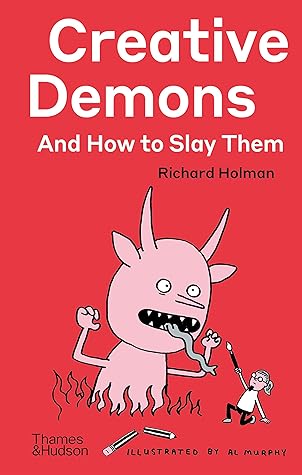Kindle Notes & Highlights
It’s a truth often remarked upon that creativity isn’t learned, it’s unlearned.
the longer you leave your demons unchecked, the more they will thrive and the bigger they will become.
Van Gogh wrote, ‘You don’t know how paralysing it is, that stare from a blank canvas that says to the painter you can’t do anything. The canvas has an idiotic stare, and mesmerizes some painters so they turn into idiots themselves.’
2014 study by researchers at Stanford University, California, found that your capacity for creative thought improves by up to 60% when you’re walking rather than sitting.
Rule number 8 is ‘Don’t try to create and evaluate at the same time. They’re different processes.’ What Kent understood intuitively has now been confirmed by neuroscience. Today, we know that imagination and evaluation happen in different regions of the brain. The more you conflate these two processes, the less successful you’ll be at both.
The candle problem is an eloquent illustration of how fixed we can become in our thinking and how hard it can be to disrupt the conventions that envelop our imagination over time. An unfortunate corollary of this effect is that the more frozen our thinking becomes, the less we are aware of it.
The second reason the Demon of Convention finds us such a soft touch is that we are social creatures, conditioned to behave as the rest of the pack does. We are viscerally afraid of shame or embarrassment.
An important first step is to acknowledge the bias we have towards conventional problem-solving strategies. When it comes to creativity, a good example is our inclination towards solutions that are additive. A research paper published in Nature in 2021 explores this phenomenon: when people are faced with a problem, they tend to solve it by adding new elements rather than taking existing components away, even when the latter is quicker, simpler and more effective.
The problem with this human tendency to add, rather than subtract, is that it can lead to clumsy, overworked ideas.
Our sheep-like tendency to follow well-worn paths is often exacerbated by education. At school we learn facts and formulae, we’re taught that there is a right way of doing things and a wrong way, even if both give the same answer.
There’s a fascinating theory about why there are so many instances of animals apparently seeking intoxication – not just the well-documented cases of elephants or birds becoming drunk on fermented fruit, or cats getting whacked out on catnip, but also wallabies munching poppies, birds chewing marijuana seeds and even dolphins getting high on the emissions from a panicked pufferfish. According to the theory, animals often become stuck in behavioural ruts, and if their environmental circumstances change they become vulnerable. Imbibing narcotics encourages them to ‘depattern’, to push beyond the
...more
Oppositional thinking requires that you first identify these conventions and then see what happens if you do the opposite.
The Demon of Constraints will almost always conjure up some kind of obstacle that we have to leap over, sidestep or break through in order to reach our objective.
If you’re a writer, what person do you normally write in? If you compose songs, what’s your favourite chord? Now paint without that colour, write in a different person or compose without using that chord.
The Demon of Criticism would have you believe that commercial and critical success is an absolute reflection of your talent and achievement. He wants you to think that without it you’ve failed. But the road to acclaim is, in the words of those lads from Liverpool rejected by Decca, a long and winding one. There are plenty of places to get lost along the way. To arrive there isn’t just about talent, it’s also about luck.
As the writer Neil Gaiman has observed, ‘When people tell you something’s wrong or doesn’t work for them, they are almost always right. When they tell you exactly what they think is wrong and how to fix it, they are almost always wrong.’
We like to believe, because we’re ego-driven, self-obsessed creatures, that each of us alone is the sole parent to our ideas. We kid ourselves that inspiration is ineffable, miraculous, a kind of magic. The muses smile upon us and – bingo! – out of nowhere pops an idea. All those influences that have led us to this point evanesce in a convenient puff of amnesia. The truth, of course, is that nothing comes of nothing.
Our success as a species rests on our ability to build on, reimagine and advance the ideas of others.
Failures are like weeds. There’s no intrinsic property to a weed that makes it a weed; it’s simply a plant that we don’t want in the garden. A failure is just an event like any other. What makes it a failure is that we judge it to be so from the limited perspective we have at the time. ‘This wasn’t a desirable or expected outcome,’ we tell ourselves, ‘and therefore it must be a failure.’
making creative work is hard. To complete a painting, a story or a song requires courage, persistence and a staunch determination not to be derailed by the demons who would stand in your way.
Unless you enjoy dictator-worthy levels of narcissism and a complete absence of critical judgment, then, I’m sorry to say, you will come to know the Demon of Disappointment.
The poet and musician Kae Tempest describes this gap with characteristic honesty in their book On Connection: ‘There is no success in writing. There are only better degrees of failure… An idea is a perfect thing. It comes to the writer in a breathless dream. The writer holds this idea in their mind, in their body; everything feeds it... But it will never be right. There is no way that a writer cannot injure that idea as they wrestle with it.’


